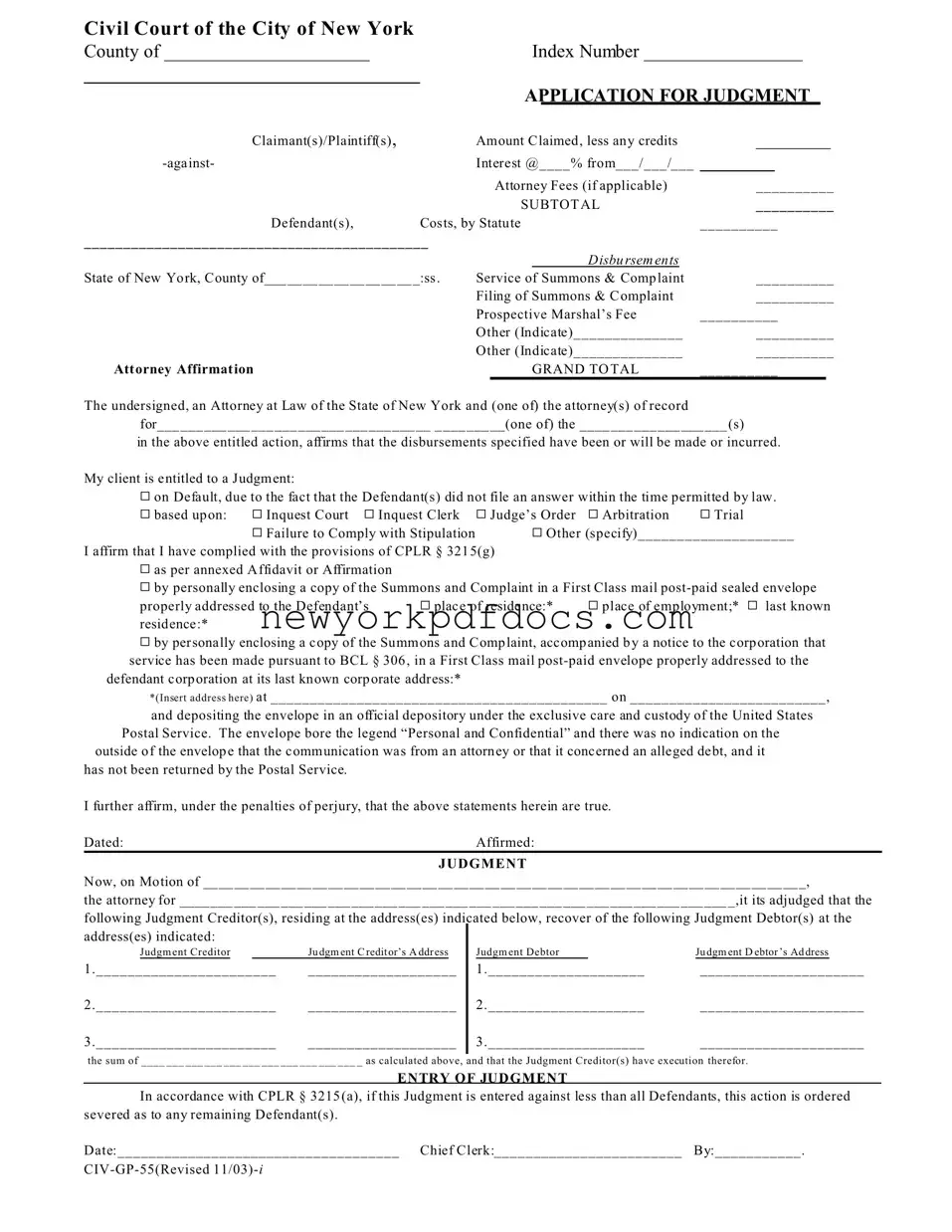
Civil Court of the City of New York
County of ______________________ |
|
|
|
Index Number _________________ |
____________________________________ |
|
|
|
|
|
|
|
|
|
|
|
|
APPLICATION FOR JUDGMENT |
|
|
|
|
|
|
|
|
Claimant(s)/Plaintiff(s), |
|
Amount Claimed, less any credits |
________ |
-against- |
|
Interest @____% from___/___/___ ________ |
|
|
|
Attorney Fees (if applicable) |
__________ |
|
|
|
SUBTOT AL |
__________ |
Defendant(s), |
Costs, by Statute |
__________ |
|
|
____________________________________________ |
|
|
|
|
|
|
|
|
|
|
|
|
|
D ISBU RSEM EN TS |
|
|
|
|
State of New Yo rk, County of___ __ __ __ __ __ __ __ __ _:ss . |
Service of Summons & Comp laint |
__________ |
|
|
Filing of Summons & C omplaint |
__________ |
|
|
Prospective Marshal’s Fee |
__________ |
|
|
|
|
Other (Indicate)______________ |
__________ |
|
|
Other (Indicate)______________ |
__________ |
Att orney Affirmat ion |
|
|
|
GRAND TO TAL |
__________ |
|
|
The undersigned, an Attorney at Law of the State of New York and (one of) the attorney(s) of record
for___ ___ ___ ___ ___ ___ ___ ___ ___ ___ ___ __ _ ___ ___ __(one of) the ____ ___ ___ ___ ___ ___ (s)
in the above entitled action, affirms that the disbursements specified have been or will be made or incurred.
My client is entitled to a Judgm ent:
Q on Default, due to the fact that the Defendant(s) did not file an answer within the time permitted by law.
Q based up on: |
Q Inquest Court Q Inquest Clerk |
Q Judge’s Order Q Arbitration |
Q Trial |
|
Q Failure to Comply with Stipulation |
Q Other (specify)____________________ |
I affirm that I have complied with the provisions of CPLR § 321 5(g) Q as per annexed A ffidavit or Affirmation
Q by personally enclosing a copy of the Summons and Complaint in a First Class mail post-paid sealed envelope
properly addressed to the Defendant’s |
Q place of reside nce:* |
Q place of employment;* Q last known |
residence:* |
|
|
Q by per sonally enclosing a c opy of the Summons and Comp laint, accomp anied b y a notice to the corp oration that service has been made pursuant to BCL § 306 , in a First Class mail post-paid envelope properly addressed to the
defendant corp oration at its last known corp orate address:*
*(Insert address here) at ___________________________________________ on _________________________,
and depositing the envelope in an official depository under the exclusive care and custody of the United States Postal Service. The envelope bore the legend “Personal and Confidential” and there was no indication on the
outside of the envelop e that the c omm unication was from an attorney or that it concerned an alleged de bt, and it has not been returned by the Postal Service.
I further affirm, under the penalties of perjury, that the above statements herein are true.
Dated: |
Affirmed: |
|
J U D G M E N T |
Now, on Motion of __ __ __ __ __ __ __ __ __ __ __ __ __ __ __ __ __ __ __ __ __ __ __ __ __ __ __ __ __ __ __ __ __ __ __ __ __ __ _,
the attorney for ____ ___ ___ ___ ___ ___ ___ ___ ___ ___ ___ ___ ___ ___ ___ ___ ___ ___ ___ ___ ___ ___ ___ _,it its adjudged that the
following Judgment Creditor(s), residing at the address(es) indicated below, recover of the following Judgment Debtor(s) at the |
address(es) indicated: |
|
|
|
|
|
Judgm ent Creditor |
|
Ju dgm ent C redit or’s A ddr ess |
|
Judgm ent Debtor |
|
Ju dgm ent D ebtor ’s Ad dress |
1._______________________ |
___________________ |
1.____________________ |
_____________________ |
2._______________________ ___________________
2._________________________________________
3._______________________ ___________________
3._________________________________________
the sum of ____ ___ ___ ___ ___ ___ ___ ___ ___ ___ ___ _ as calculated above, and that the Judgment Creditor(s) have execution therefor.
E N TR Y O F JU D G M E N T
In accordance with CPLR § 3215 (a), if this Judgment is entered against less than all Defendants, this action is ordered severed as to any remaining Defendant(s).
Date:____________________________________ Chief Clerk:________________________ By:___________.
CIV-GP-55(Revised 11/03)-I

